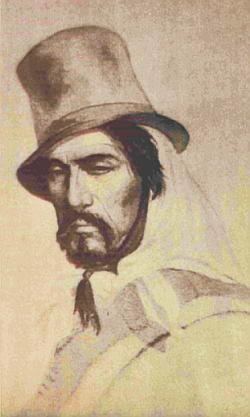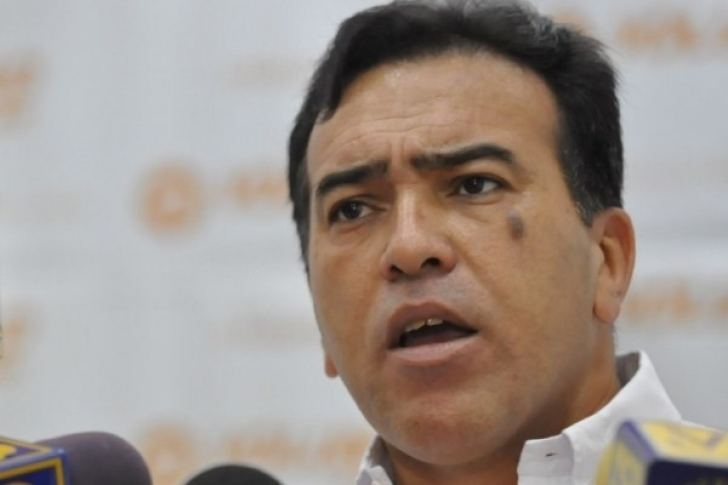Name Antonio Rivero | ||
 | ||
Died November 20, 1845, San Pedro, Argentina | ||
Ex general antonio rivero llama a la violencia pero se desmaya al ser detenido
Antonio “El Gaucho" Rivero was a gaucho who murdered the five leading members of the settlement of Port Louis on the Falkland Islands on 26 August 1833.
Contents
- Ex general antonio rivero llama a la violencia pero se desmaya al ser detenido
- Al Gaucho Antonio Rivero
- Biography
- Legacy
- In popular culture
- References

Al Gaucho Antonio Rivero
Biography
Rivero was born in Concepción del Uruguay, at that time a rural village in Entre Ríos Province, Viceroyalty of the Río de la Plata, now part of Argentina on November 27, 1808.
When he was about 20 years old, he was taken to the Falkland Islands by Luis Vernet, to work as a gaucho. Conditions of employment caused discontent among Vernet's workers. They were paid with promissory notes which Matthew Brisbane, Vernet's deputy, devalued following the reduction in Vernet's fortunes. On 26 August 1833, five Indian convicts and three gauchos led by Rivero embarked on a killing spree which resulted in the deaths of Brisbane and the senior leaders of the settlement. Thomas Helsby, a clerk in the employ of Vernet, wrote an account of the murders.
At around ten in the morning, Helsby departed Brisbane's house to buy some oil from William Dickson, whom he found at the house of Antonio Wagner. Other people there included Daniel McKay and Joseph Douglas. On leaving, as he passed the house of Santiago Lopez, Helsby encountered the murderers. The gang was led by Rivero and comprised the gauchos José María Luna, Juan Brasido and the five Charrúa Indians Manuel Gonzales, Luciano Flores, Manuel Godoy, Felipe Salagar and Lattorre. They were armed with "muskets, pistols, swords, dirks and knives".
Alarmed, Helsby ran to Brisbane's house for aid, but he found it locked and could raise no response. He was informed by other residents that Brisbane had been killed, along with Juan Simon (the Capitan of the Gauchos). A third man, Don Ventura, had been left for dead, wounded in the throat by a musket, his head split and his hand almost severed by a sword, but he had since escaped by a back window and headed toward the house of Antonina Roxa. Helsby then heard two musket shots from the house of Antonio Wagner: Wagner and Dickson had been killed, witnessed by Joseph Douglas and Daniel McKay.
The gang then returned to Brisbane's house to find Ventura missing. After a brief search they found him. Ventura tried to flee, but was shot down. Helsby witnessed the murder and attempted his own escape, but was soon caught by Felipe Salagar, who was on horseback. Convinced he was about to be killed, he complied with their instructions, and was allowed to live.
The population of that time, mainly women and children, fled to the nearby Peat island, until rescued by the sealer Hopeful in October 1833, which then passed information about the murders to the British squadron at Rio de Janeiro.
In January 1834, the British ship HMS Challenger arrived in the islands, bringing Lt. Henry Smith, who set out to capture the murderers, who fled into the interior. The gang was sent for trial in London, but under the British Legal system could not be tried because the Crown Court did not have jurisdiction over the Falkland Islands at the time of the alleged offences. In the British colonial system, colonies had their own, distinct governments, finances, and judicial systems. Rivero was not tried and sentenced because the British local government and local judiciary had not yet been installed in 1834; these were created later, by the 1841 British Letters Patent. Subsequently, Rivero has acquired the status of a folk hero in Argentina, where he is portrayed as leading a rebellion against British rule. However, all five of the victims of the massacre were employees of Vernet. They were deported to Rio de Janeiro, and returned later to the zone of the Río de la Plata.
The circumstances of Rivero's death are unknown.
Legacy
The initial British plans for the Falklands were based on the perpetuation of Vernet's settlement, backed by an annual visit by a warship. This was the standard practice of maintaining a settlement with the minimum of expense. Thus, there was no British presence in the islands at the time of the Port Louis murders. A direct result of the murders was the installation of a permanent British Government presence – Lt Henry Smith became the first British resident in January 1834. Subsequently, the permanent presence led to the decision in 1841 to form a permanent colony rather than a minor naval outpost.
In popular culture
Armando S. Fernández wrote in 2008 a historical novel about Rivero, called "El Gaucho Rivero y la conspiración para apoderarse de Malvinas".
In 2011 and 2012, starting at Tierra del Fuego Province, Argentine provinces with shores to the Atlantic ocean passed a bill that banned ships sailing under the British flag from docking in their ports. These laws were collectively known as Ley Gaucho Rivero, as originally named in Tierra del Fuego, after Antonio Rivero.
In 2015, a new banknote was issued by the Argentine government themed on the Falkland Islands. In the reverse, Antonio Rivero is depicted on a horse flying the flag of Argentina.
